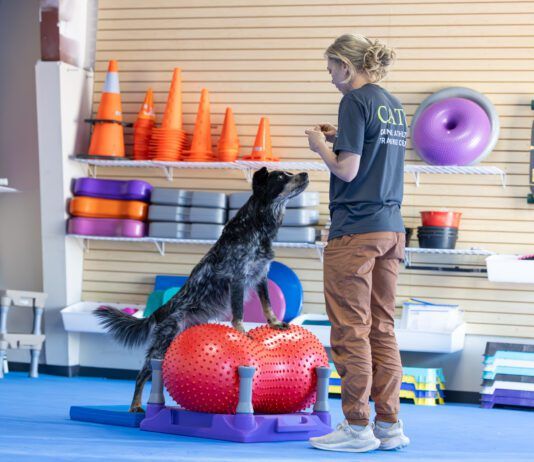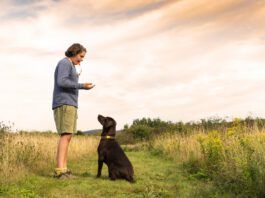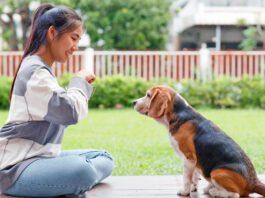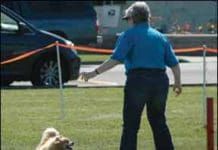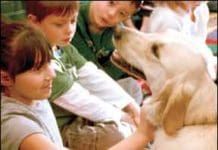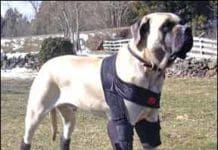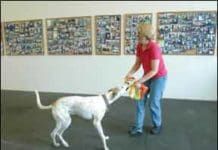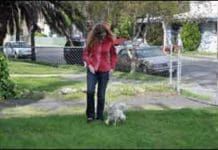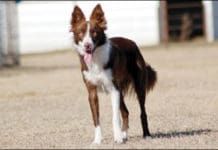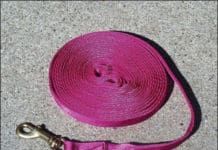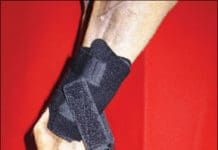Dog Crate Anxiety
Properly used, the crate is a marvelous training and management tool. Improperly used, it can be a disaster. Overcrating, traumatic, or stimulating experiences while crated, improper introduction to the crate, and isolation or separation anxieties are the primary causes of crating disasters. If, for whatever reason, your dog is not a fan of the artificial den you've provided for him, and assuming he can't be trusted home alone uncrated, here are some things you can do...
Frustrated With How Your Dog’s Training is Going?
an obedience class
Orthopedic Equipment for Dogs that Increase Joint Support and Overall Mobility
In our March 2011 issue, we introduced you to a very small sampling of some of the neat “assistive equipment” options that are available to help our canine companions who have limited mobility or other physical issues. We received such a great response that we thought we’d share with you a few more finds that can help make life easier for you and your dog, particularly if he or she is aging or has orthopedic or neurologic issues. Remember: the products mentioned here are only the tip of the iceberg. There are numerous companies making innovative assistive products; what we’re hoping to do here is to get you thinking about some of the possibilities!
5 Ways to Train Without Treats!
Food treats are an easy and effective reward for a dog when training. But food rewards are only one way to build strong behavior. There may be times when you do not want to or cannot use food, and there may be times when the best reinforcement is something other than a hot dog! Here are five great ways to reward your dog when you don't want to reach for the treat pouch.
What Does The Dog Think?
Current research has demonstrated that many species, including our beloved canines, share brain circuitry very similar to the human part of the brain that controls emotion the amygdala and the periaqueductal grey. While there's no doubt among most dog lovers that dogs have emotions, this concept is still being discussed in the halls of academia. Some insist that even though animals show emotional behaviors that we can observe, we can't assume the behaviors mean the animals who display them have emotional feelings. (I don't know how anyone can think this, but some scientists really do!) Others, such as the esteemed neurobiologist Dr. Jaak Panskepp of Washington State University, argue that if it walks like a duck and quacks like a duck it's probably a duck!
An Observation Technique That Will Improve Your Dog Training
How well do you really know your dog? Like most trainers and competitors, Nancy Tanner of Bozeman, Montana, assumed she knew hers inside out – until some whales and their trainers taught her an important lesson. You too can adopt the simple technique she learned at a marine mammal park to improve canine interactions at all levels.Tanner’s path of discovery began five years ago at Sea World in San Diego, California, where she took a behind-the-scenes tour. What caught Tanner’s attention was the whales’ “free-time pool.” In this large, safe, comfortable environment, whales do whatever they like. Sometimes the pool is occupied by a single whale and sometimes by two or more. Trainers are always present but they never initiate activity. They simply watch and wait.
How to Train Hearing Impaired Dogs Using Hand Signals and Simple Gestures
I was recently contacted by a friend about a darling Border Collie puppy whose photo she found on Petfinder.com – and who was deaf. This friend is crazy about Border Collies, and also knows that I have a deaf Chinese Crested. Thus, she thought of me when she saw this puppy. The person who was fostering the pup was unable to keep her much longer, and did not want to send her to the local shelter as that would almost certainly result in the puppy’s euthanasia. Why? Because that shelter considers all deaf dogs as “unadoptable.”
Try Treibball! The New Herding Sport – No Sheep Required
but so are any dogs that like to play with balls and dogs that enjoy shaping games. This is Kula
What’s In a Dog’s Name?
The January issue of Whole Dog Journal featured “Say My Name,” an article by Pat Miller that explained the importance of teaching your dog to recognize and respond to his or her name. In a sidebar to that article, Pat also discussed the issue of naming (or renaming) your dog. And she announced a little contest for our readers, asking you to share the story of how you selected your dog’s name and why. Pat said she would select some winners and the “top three” would win a signed copy of her newest book, Do Over Dogs: Give Your Dog a Second Chance for a First Class Life.
Selecting the Correct Leash Length for Your Various Leash Training Exercises
When you think “leash,” chances are you think of a four-to-six-foot strap made of nylon, cotton, hemp, leather, or (horrors!) chain, with a snap that attaches to your dog’s collar at one end and a handle for you to hold at the other. You use it to keep him close to you when you take him for walks or other places where he has to be under control. But a leash can be so much more than that! Let’s think outside the box. There’s no law that says leashes have to be a certain length, made of a particular material, or be limited to one snap and one handle. There are all kinds of things you can do with non-traditional leashes. Heck, there’s even a good use for the grocery store chain leash.
Orthopedic Equipment for Dogs Designed for Increased Mobility and Extra Support
Do you have a dog recovering from orthopedic or neurologic surgery, one who has mobility issues, or a senior dog who has arthritis? If so, at some point, you have probably wished you could do something anything! to help make your dog's life (and your own) a little easier. I asked two veterinarians who specialize in canine rehabilitation to share some of their top picks for canine assistive/rehabilitative equipment. Laurie McCauley, DVM, CCRT, is founder and medical director of TOPS Veterinary Rehabilitation in Grayslake, Illinois, and is considered one of the pioneers in the field of veterinary rehabilitation. Evelyn Orenbuch, DVM, CAVCA, CCRT, recently opened Georgia Veterinary Rehabilitation, Fitness and Pain Management in Marietta, Georgia, and has focused on veterinary rehab medicine since 2003.


